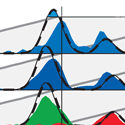Quantum simulation of an old paradox
The quantum-mechanical behavior of even simple systems can be hard to calculate using classical computers. Experimenters are exploring various ways to simulate this behavior by measuring what happens in analogous quantum systems whose parameters can be precisely controlled.
Writing in Physical Review Letters, René Gerritsma and colleagues at the University of Innsbruck, Austria, and collaborators in Spain use trapped ions to reproduce the classic Klein paradox, in which a relativistic particle seems to be transmitted unhindered into a potential barrier. If the barrier is large and abrupt enough, the particle can effectively continue on by transforming into its antiparticle, according to equations that describe single relativistic particles.
The mathematical mixture of particle and antiparticle that appears in these equations is represented in Gerritsma et al.’s experiment by a superposition of two electronic states of a single trapped ion. Similarly, position (in space) maps to a vibrational excitation on the ion, which the researchers coupled to the ion’s electronic state using laser illumination. Introducing a second ion lets them mimic a tunable potential that increases linearly with position. As expected from the equations describing the Klein paradox, a simulated “particle” wave packet reflects almost completely from a gently inclining potential. But a steeper potential induces a partial switch to the “antiparticle” state, which continues propagating into the barrier.
Quantum simulation of systems with additional particles only requires including more ions in the trap, the authors say, and could be a tool for emulating systems beyond practical reach for classical computations. – Don Monroe





